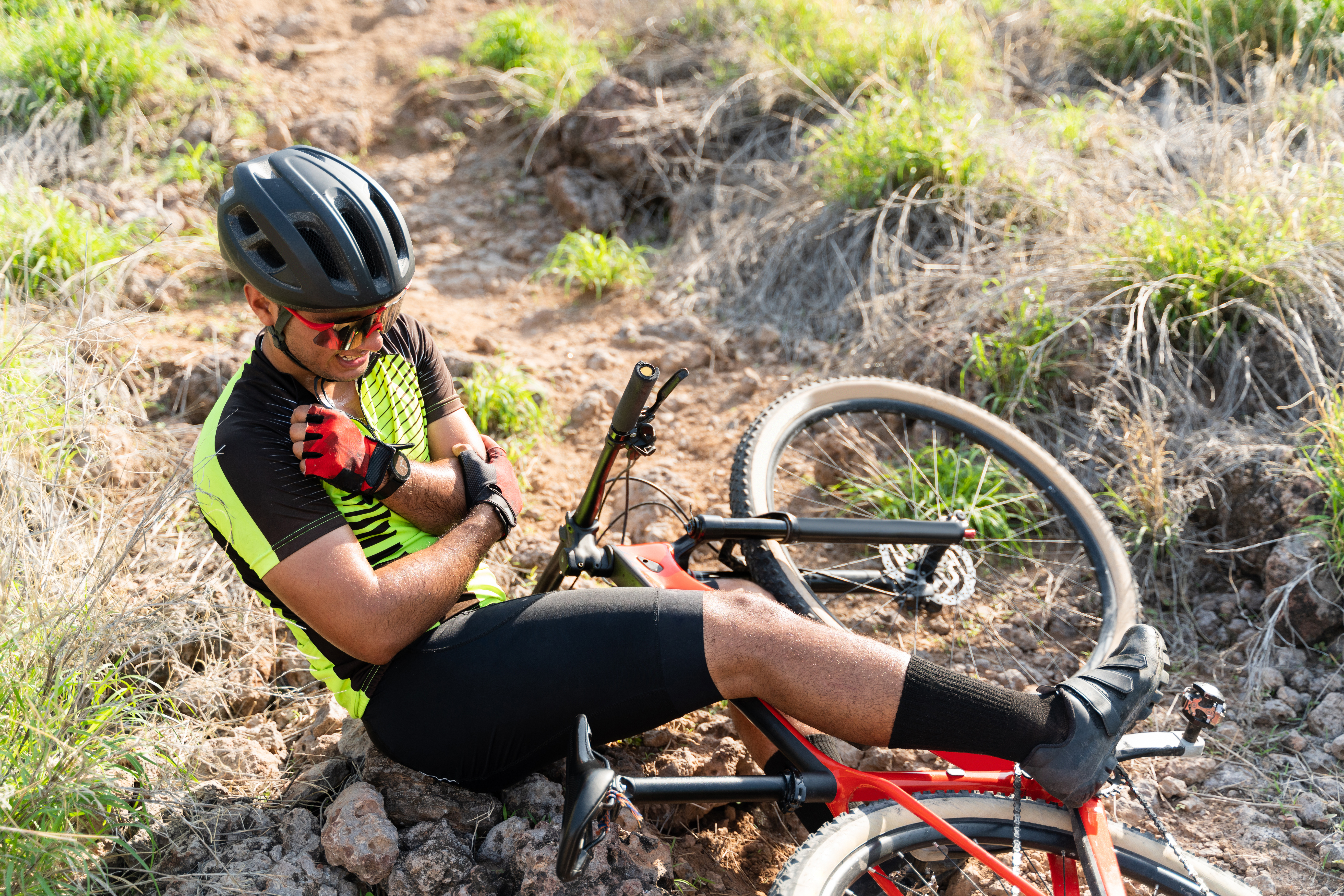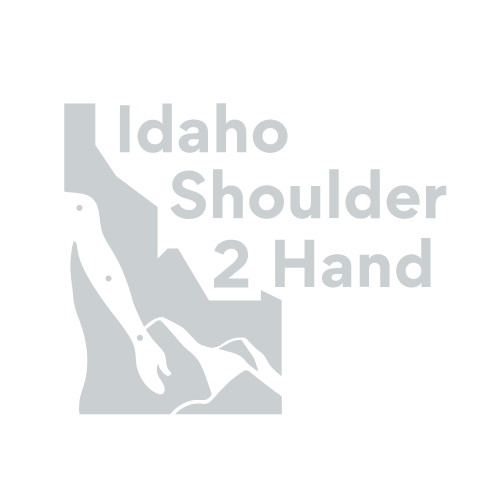Cycling Injuries in the Upper Extremity
Whether barreling down a Bogus Basin trail, cruising along the Boise Greenbelt, or riding the backroads of the beautiful Idaho scenic byways, both competitive and recreational cyclists are at risk of suffering from traumatic or overuse injuries to the shoulder, elbow, wrist, or hand. The legs may drive the bike, but the upper extremity absorbs the shocks of the surface and protects the body during a fall. Such stress puts the entire upper limb, from the collar bone to the fingertip, to a wide variety of traumatic and atraumatic injuries involving the shoulder, elbow, wrist, and hand. Fortunately, with the right care, even the most severe injuries can be treated effectively so that the cyclist can get back in the saddle. Unlike head injuries that can be prevented with the use of helmets, the upper extremity is relatively unprotected during cycling activities. The need to allow freedom of motion of the shoulder, elbow, wrist, and hand to maneuver and handle a bike makes the use of protective gear difficult during cycling.
Chronic Injuries
The most common upper extremity issues are, by far, traumatic in nature. Chronic injuries, however, are not uncommon with high impact or endurance cycling activities.
Compression Neuropathies
Compressive neuropathy of the median or ulnar nerve, also known as carpal tunnel and cubital tunnel respectively, can occur by prolonged hyperextension positioning of the wrist during cycling and/or prolonged flexion of the elbow during prolonged aerodynamic positioning. The symptoms of numbness and tingling in the fingers can cause weakness in the hand and loss of dexterity of the fingers. If the symptoms become recurrent, persistent, or more severe with time, an evaluation by a hand surgeon is recommended. Prior to seeing the hand surgeon, obtaining a simple test called a nerve conduction test, performed by a neurologist or physical medicine & rehabilitation doctor, will confirm the diagnosis and quantify the severity of the nerve compression. Despite some popular myths, these compression neuropathies are all too often progressive and ultimately require a simple surgical procedure to eliminate the nerve compression problem. Carpal tunnel surgery is a 5-minute outpatient surgery done through a minimally invasive endoscopic approach under local anesthesia. Recovery is a progressive return to full function over the course of 2 weeks. Cubital tunnel surgery is an outpatient surgery performed under regional anesthesia through a small incision across the inside of the elbow. The recovery is like carpal tunnel surgery. In some instances where a cyclist is dealing with both nerve compression problems, both surgeries can be done at the same time with the same 2-week recovery period.
Tendinitis and Bursitis
Prolonged or repetitive shock to the upper extremities on tough terrain during mountain biking or prolonged unnatural position of the extremities during road biking can lead to chronic conditions such as tendinitis.
Finger Tendinitis
Tendinitis of the flexors of the wrist and fingers can develop from prolonged gripping of the handlebars and repetitive shifting of the gears and use of brakes. Finger tendinitis can lead to symptoms of stiffness in motion and loss of the ability to make a closed tight fist to grip the handlebars. Inflammation of the flexor tendon of the finger can lead to a condition known as a trigger finger. A trigger finger is when the finger catches and gets stuck during flexion and extension – mimicking a “trigger” effect. The treatment for a trigger finger can be as simple as a one-time cortisone injection into the flexor sheath of the finger tendon involved. In about 50% of persons, a one-time injection is curative of the problem. In individuals who develop recurrent triggering of a digit, a 5-minute minor surgical procedure known as a trigger finger release can definitively cure the problem. Like carpal tunnel surgery, the recovery for a trigger finger surgery is a progressive 2-week recovery to full use.
Wrist Tendinitis
Tendinitis about the wrist can develop from the awkward and/or prolonged gripping of the handlebars. Most wrist tendinitis develops along the extensor tendons of the wrist, fingers, and thumb. The wrist and finger/thumb extensor tendons run across the dorsal aspect of the wrist in 6 separate compartments. The most common wrist tendonitis involves the 1st and 6th compartments. The 1st dorsal wrist compartment contains the short thumb extensors. Tendinitis of this compartment is known as radial styloid tenosynovitis or Dequervain’s tenosynovitis. The 6th compartment contains the ulnar wrist extensor known as the Extensor carpi ulnaris (ECU). Inflammation of these extensor tendons is most often treated with a course of NSAIDs, bracing, ice, and home exercises. For resistant or sever cases, a one-time cortisone injection into the affected compartment can provide definitive resolution. Like a trigger finger injection, up to 50% of patients experience complete resolution with a one-time cortisone injection. In individuals who develop recurrent extensor tendinitis, a 15-minute minor outpatient surgical procedure can definitively cure the problem. Like carpal tunnel and trigger finger surgery, the recovery for an extensor tenosynovectomy procedure is progressive 2-week recovery to full use.
Forearm Tendinitis
Forearm tendinitis conditions for the flexors or extensors of the wrist and digits is often initially treated with conservative home-based exercises programs and/or physical therapy. Elbow and forearm tendinitis is known by several names. On the lateral (outer, dorsal) side, the condition has been called lateral epicondylitis and tennis elbow. One medial (inside, volar) side, the condition has been called medial epicondylitis or golfer’s elbow. For severe cases that cause dysfunction of the upper extremity, a one-time cortisone injection can be performed to decrease pain and acute inflammation. Repetitive cortisone injections are not recommended for these conditions. If the tendinitis becomes chronic or resistant to conservative treatments, minimally invasive treatments such as percutaneous needle tenotomy can accelerate recovery and return to function.
Shoulder Tendinitis
Like the elbow, cyclists can develop chronic shoulder bursitis due to repetitive shock stress from rough terrain encountered on the mountain bike or prolonged body positioning over the handlebars during road cycling. Individuals often develop pain and restricted shoulder motion, especially overhead motions. Sometimes, individuals will experience a popping sensation with shoulder rotation. Treatment is generally non-surgical with NSAIDs, modalities like ice and heat, home exercises, an occasionally physical therapy. For shoulder tendinitis that fails to resolve with these conservative measures, evaluation by a shoulder specialist may become necessary for further evaluation to look for more subtle injuries such as rotator cuff tears, labrum injuries, biceps injuries, or aggravation of arthritis. Deciphering the correct diagnosis is critical to implement the right treatment. An upper extremity fellowship trained shoulder specialist can help the individual get the best treatment to achieve the optimal outcome as quickly as possible.
Arthritis
Osteoarthritis conditions can be aggravated by hand positioning during cycling. Arthritis of the base of the thumb, known as carpometacarpal/basal joint arthritis, is a very common form of osteoarthritis in the hand. Other arthritis conditions of the wrist, elbow, and shoulder region (both acromioclavicular and glenohumeral joints) can also be aggravated by body position during cycling.
The key to effective treatment for these chronic injuries is to be evaluated by an orthopedic upper extremity surgical specialist who is experienced in treating conditions of the shoulder, elbow, wrist, and hand as accurate diagnoses of these conditions can be confounded by other problems that can mimic similar symptoms.
Traumatic injuries such as fractures and dislocations are less subtle in their diagnoses but often require surgical expertise that can only be provided by a fellowship trained specialist in hand, wrist, elbow, and shoulder surgery.
Fractures About the Upper Extremity from Cycling Injuries
Clavicle Fractures
The classic fracture experienced by cyclists is the fracture of the clavicle, aka the collar bone. This injury occurs when the cyclist falls either onto their side or tumbles over the handlebars and lands onto their shoulder. The force of impact causes the clavicle to break. Fortunately, most clavicle fractures can be treated non-surgically with a sling or special brace known as a figure-of-eight harness. However, surgical indications to fix these fractures have become clearer in recent years. The key is to recognize which fracture patterns should be fixed to prevent future issues with deformity and poor functional recovery of the shoulder. The technologies used in surgically repairing clavicle fractures have evolved to allow shoulder and upper extremity surgeons the ability to achieve excellent results from operative reduction and fixation. Surgical open reduction and internal fixation of clavicle fractures has shown in many cases to help patients achieve early pain relief and early restoration of simple functional use of the affected upper extremity compared to nonsurgical treatment. A fellowship trained upper extremity surgeon who specializes in shoulder surgery can help individuals determine the best treatment option for them.
Wrist Fractures
Like the general population, cyclists are more likely to suffer a fracture about the wrist from a fall. The most common wrist fracture is that sustained to the distal radius. The radius is one of the forearm bones. The distal part of this bone makes up the joint surface that support the wrist bones known as the carpal bones. Distal radius fractures are often associated with fracture of the distal ulna, the other forearm bone. The distal ulna is important to the stability of the distal radial-ulnar joint, aka the DRUJ. Aside from distal radius injuries, cyclists can also suffer carpal bone fractures, the most common of which is a navicular (scaphoid) fracture. The key to proper care is recognizing the fracture patterns and associated ligament injuries so that the appropriate care, often surgical, can be provided to achieve the best results. Wrist fractures and associated ligament injuries should be evaluated by a fellowship trained hand surgeon.
Shoulder, Arm, Elbow, Forearm Fractures
Other less common but sometimes more complicated injuries to the upper extremity are fractures involving the arm bone (humerus – proximal and distal), elbow region (radial head, olecranon), and forearm (radius and/or ulna). The key to proper care is recognizing the subtleties involved in these injuries so that appropriate treatment, often surgical treatment, can be provided to achieve the best results and outcomes. Evaluation by a fellowship trained shoulder surgery specialist can help individuals achieve the best outcomes for these often-complicated injuries.

Hand, Thumb, Finger Fractures
Finger, thumb, and hand fractures often result in cyclists from landing onto their outstretched hand during a fall. Treatment for these fractures can be complicated and must be followed closely to ensure that individuals can recover the best function for their hand. These injuries should be evaluated and treated by a fellowship trained hand surgeon.
Dislocations About the Upper Extremity
AC Separations
Another classic shoulder injury in cyclists involves the separation of the acromioclavicular joint. These injuries are known as shoulder separations or AC separations. This injury occurs when the cyclist falls onto the side of their shoulder or tumbles over the handlebars and lands onto the top of their shoulder. The impact causes the ligaments that stabilize the AC joint to tear. The severity of the injury and therefore the number of ligaments that are torn determine the right course of treatment. AC separations are categorized by the level of “separation” between the clavicle and the acromion bone at the AC joint. Type 1 and Type 2 AC separation injuries are treated symptomatically and tend to resolve with time. Type 3 AC separation injuries can be treated either conservatively or surgically. The determining factor for treatment is often the level of pain and instability of the joint with shoulder motion. Like the evolution in the treatment of clavicle fractures, new technologies in the treatment of AC separations have allowed shoulder and upper extremity specialty surgeons to help individuals achieve quicker functional recovery for the upper extremity. Type 4, 5, and 6 injuries are considered surgical emergencies. Fortunately, these latter injury patterns are not common. Evaluation by a fellowship trained upper extremity surgical specialist can help individuals achieve the best outcomes for these often-complicated injuries.
Shoulder Dislocations
Dislocations of the proper shoulder joint (glenohumeral joint dislocation) involves an injury in which the ball of the shoulder joint dislocates out of the socket. The direction of dislocation (anterior, posterior, or inferior) depends on the mechanism of the fall and the direction of the force onto the arm. Dislocations of the shoulder joint often need to be manually reduced at the scene by a trained provider or in the emergency room. Near dislocations, known as traumatic subluxations, is a condition in which the individual feels that the as if their shoulder came out of socket and went back in on its own. Dislocations can be associated with fractures of the humeral head and glenoid, tears of the labrum, and rotator cuff tears. Treatment for these injuries requires a plan that is personalized to the individual and their goals, expectations, and requirements. After the acute reduction of a dislocation has been done, often in the emergency room, follow up evaluation with a fellowship trained shoulder specialist who is well trained in treating these complex injuries is necessary to achieve the best outcomes for these complicated injuries.
Elbow Dislocations
Like shoulder dislocations, elbow dislocations are considered a major injury to the upper extremity. These injuries are very often associated with fractures and/or ligament injuries. Like shoulder dislocations, acute reduction of the injury is required on the scene by a trained individual or in the emergency room. The direction of the dislocation and severity of the injury depends on the mechanism of injury. Treatment for these injuries requires follow-up with a fellowship trained upper extremity surgeon who is well versed in treating these complex injuries to achieve the best possible outcome.
Wrist, Hand, Finger, Thumb Dislocations
Wrist, hand, and finger/thumb dislocation injuries can occur from a fall onto the outstretched hand. These can often be associated with ligament injuries and fractures. These injuries, like shoulder and elbow dislocations, require acute emergency evaluation and treatment for reduction. Definitive treatment requires follow-up with a fellowship trained hand surgeon to achieve the best possible outcome for these complex injuries.
The Key to Achieving the Best Possible Outcome from an Upper Extremity Cycling Injury
The key point in any injury to the upper extremity is to seek evaluation by a dedicated upper extremity specialist after emergency stabilization and care has been provided. Seemingly simple injuries to the shoulder, elbow, wrist, hand, and fingers are often referred to the general orthopedist. To truly obtain optimal results to maximize their return to function requires the care of a specialist trained in shoulder, elbow, wrist, and hand orthopedic care. With precise, timely, and expertise treatment, a cyclist can return to their chosen sport, recreation, and passion no matter how complex the nature of injury to the upper extremity.

